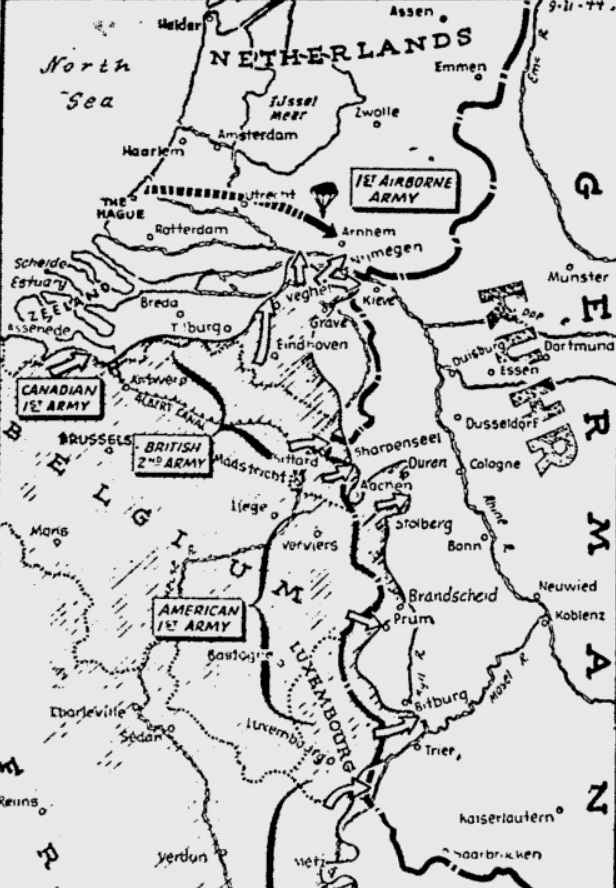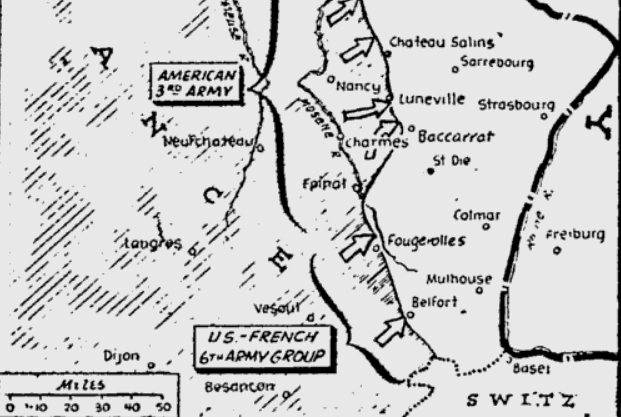The Pittsburgh Press (September 21, 1944)
AIR ARMY RESCUE REPORTED
New offensive hits Siegfried Line
Allied mobile forces race over Rhine after taking bridge intact
By Virgil Pinkley, United Press staff writer
*Cracking the Rhine Line, British 2nd Army tanks and U.S. airborne troops raced northward from Nijmegen for a reported rescue of an Allied airborne force trapped in the Arnhem area of Holland. Meanwhile, the 1st Canadian Army and Polish troops cleared virtually the entire south bank of the Scheldt estuary to open the captured port of Antwerp to Allied shipping. The U.S. 1st Army launched a new offensive against the Siegfried Line below Aachen. The U.S. 3rd Army drove against Metz and advanced from Nancy, while the Allied 6th Army Group continued its drive toward Belfort.
Bulletin
SHAEF, London, England –
**Counterattacking German troops were thrown back with heavy casualties by the U.S. 1st Army in an hours-long battle northwest of Trier today, while to the southeast Nazi tank losses mounted past the 100-mark on the third day of a great armored battle on the 3rd Army front.
SHAEF, London, England –
The U.S. 1st Army opened a new offensive against the Siegfried defenses southeast of Aachen today while to the northwest Allied mobile forces raced beyond the Rhine toward an imminent junction with airborne troops encircled in the Arnhem area of Holland.
Berlin in effect reported that sky troopers at Arnhem had been relieved by U.S. and British forces pouring over the Rhine on a Nijmegen road bridge captured in a battle through the streets of the strategic Dutch town which is a gateway to Northwest Germany.
The Allied campaign in Western Europe is “well over a month” ahead of schedule, a broadcaster reported from Paris on his arrival from Gen. Dwight D. Eisenhower’s new command post in eastern France, adding that “so now it is forward to Berlin.”
The U.S. 8th Air Force sent about 500 of its Flying Fortresses and Liberators to the Rhineland to hammer the strongholds of Mainz, Coblenz and Ludwigshafen, directly in front of the U.S. 1st and 3rd Armies.
Despite bad weather other Allied air formations continued pouring strength into Holland, Allied headquarters disclosed that 11,500 sorties had been flown in the airborne operation which began Sunday, not including the gliders involved.
Headquarters advices disclosed that Lt. Gen. Courtney H. Hodges’ 1st Army had struck out through the dank, mine-strewn Hürtgen Forest southeast of Aachen in a new drive on German soil.
Details were few regarding the scale and progress of the new attack in the sector where a few days ago Gen. Hodges drove a wedge through the Siegfried Line.
The battle was reported going on in the area south and east of Stolberg, 642 miles east of Aachen, with the doughboys making progress against stiffening resistance.
The imminent linkup of the armored column speeding up from the Nijmegen area and the airborne force at Arnhem 10 miles to the north will clear the way for a further swing around the Siegfried Line, which ends at Kleve, 18 miles southeast of Arnhem.
The German DNB News Agency reported that the Germans had captured the staff headquarters of the 1st Airborne Division north of Eindhoven, but there was no confirmation in responsible quarters.
Of three bridges across the Rhine which were attacked by massed Allied tank forces, DNB said, the Germans blew up two and held a third.
However, dispatches from the Allied front told of the capture of the Nijmegen road bridge by the British 2nd Army with the aid of U.S. airborne units who crossed the river northeast of Nijmegen and advanced along the northern bank.
At Arnhem, the Allied position was unchanged, with the heaviest fighting going on around the town, United Press writer Ronald Clark reported. He said the British had strengthened the flanks of their north-south axis in Holland and “there now appears no chance that the enemy will be able to cut across the axis.”
The Nazis were throwing their zealously hoarded tanks into battle at a number of points. Armored clashes of mounting intensity were reported from both the 1st and 3rd Army fronts.
A German military spokesman quoted by the Berlin radio reported a “narrow passage of communications” between the Nijmegen and Arnhem groups, indicating that advanced elements had made a junction. He said the passage was under heavy gunfire and virtually useless as a supply route.
Only a few narrow canals between Nijmegen and Arnhem barred the way to the broad German plains sweeping 260 miles beyond the Dutch border to Berlin, and it appeared that the Germans had little left in the immediate area to halt the American and British thrust.
First word of the dramatic crossing came in a front dispatch from BBC correspondent Stewart McPherson, who reported that the Americans made an assault crossing near the main highway bridge late last night and cut in behind the Germans who were defending the span against a British frontal attack.
Under the front and rear attack, the Germans broke and fled, leaving the key bridge intact for a flood of British armor to stream northward to the rescue of the airborne troopers at Arnhem.
At the same time, headquarters revealed that the U.S. 1st Army to the south drove another spearhead into Germany at Scherpenseel, 11 miles north of Aachen, after a swift advance across the narrow neck of Dutch soil separating Belgium from the Reich.
Other 1st Army troops were locked in a violent battle for the German factory town of Stolberg, while Lt. Gen. George S. Patton’s 3rd Army closed to within six miles of Metz and ground slowly forward against fierce armored counterattacks northeast of Nancy.
The Germans, faced with the possible loss of 100,000 men pinned against the Dutch coast west of Nijmegen, as well as a direct invasion blow toward Berlin, were throwing every available man, gun and tank into the Netherlands battle.
Fight hard for bridge
Handpicked Nazi troops fought like wild men to hold the Nijmegen bridge and other German tank and infantry units, backed up by heavy artillery, struck repeatedly but vainly against the west wall of the thin Allied corridor stretching up from the Belgian frontier to Nijmegen.
Strong German forces still remained inside Nijmegen even after the breakthrough across the Rhine bridge. They were fighting from house to house and street to street with U.S. paratroopers who rode the turrets of British tanks rifles and machine-guns blazing.
The original U.S. airborne force landed in the Nijmegen area had been assigned to take the bridges and hold them open for the advancing British armor, but they were repulsed twice in the first 48 hours. Meanwhile, the Germans poured in heavy reinforcements from the west and simultaneously tried desperately to wipe out the airborne pocket around Arnhem – believed to be predominantly British paratroops.
Nazi planes attack
The Nazi Air Force sneaked into the battle under cover of a heavy ground mist that hampered but did not stop the flow of Allied airborne reinforcements to the front, but front reports said the enemy’s raids were on a hit-and-run scale and generally had little effect. In one savage raid on Eindhoven Tuesday night, about 20 German bombers inflicted heavy destruction on the Dutch city and killed 60 townspeople.
The main German ground attacks against the Allied corridor to the Rhine centered in the area east of Turnhout. near the base of the spearhead. particularly in the Groot Bosch area on the Belgian-Dutch border.
Expand base
Headquarters said. however, that, the base was being expanded steadily and that men and armor were moving up swiftly and in strength to join the assault across the Rhine.
The breakthrough at Nijmegen came at a critical point in the battle when the airborne troops at Arnhem had been under terrific pressure from all sides for more than 48 hours. Front correspondents with the surrounded paratroops said the sound of Allied guns in the south was drawing steadily closer and that hope for an early juncture with their main forces was rising.
Meanwhile, Gen. Hodges’ 1st Army troops battled across the neck of Holland above Aachen against heavy shellfire to the town of Scherpenseel, five miles inside the border.
Tighten noose on Aachen
Other 1st Army infantrymen to the south tightened their noose around Aachen, leaving only a narrow escape corridor open to the northeast. The noise of heavy demolitions from inside the city suggested the enemy garrison might be preparing io abandon it and withdraw toward the Rhine.
United Press writer Jack Frankish reported that the 1st Army was meeting its bitterest opposition since D-Day all along the front, encountering German flamethrowers for the first time on one sector. Ten Nazi tanks were knocked out at one point, while heavy casualties were inflicted on German troops fighting a house-to-house battle for Stolberg.
Drive toward Saar
Equally ferocious resistance faced Gen. Patton’s troops farther south as they slugged their way slowly eastward from the Moselle River toward the Saar Valley. One infantry force battered into the Sillegny area, about six miles south of Metz and about the same distance east of the Moselle. Two 3rd Army spearheads were also fighting their way northeast of Nancy against strong German armored forces.
A dispatch from United Press writer Robert C. Richards said at least 53 enemy tanks, including some 60-ton Tiger tanks, were smashed by the Americans in fighting that often raged almost “tread-to-tread.”
Battle with knives
The Germans were strongly dug in at Château-Salins, barring the eastward push to the Rhine, and Mr. Richards said the Americans at one point fought with knives and bare fists to beat off an infantry counterattack in that sector. Other U.S. forces were advancing in the Dreux and Moyenvic areas, east and southeast of Château-Sains.


